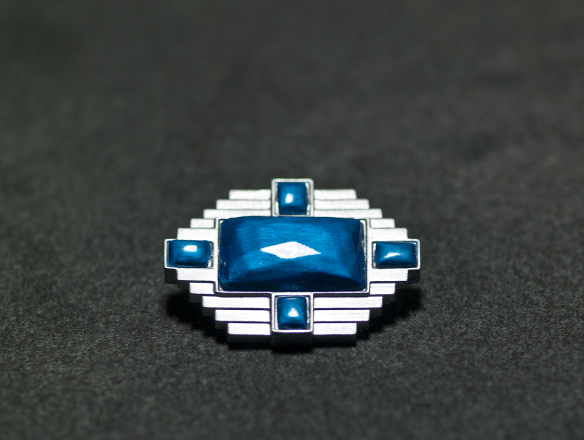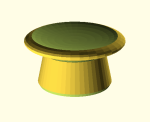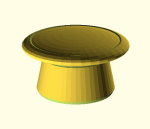I’ve said before that the aesthetics of the Form 1 make me want to 3D print artistic things, not mundane things. Over the past 6-7 months, as I’ve messed around with smaller, more refined 3D objects, I’ve inadvertently strayed into an area that I have had no previous experience with: jewelry.
Tag Archives: design
Printing the unprintable
 In the world of 3D printing, you’ll sometimes end up with models that — for one reason or another — just don’t want to be printed.
In the world of 3D printing, you’ll sometimes end up with models that — for one reason or another — just don’t want to be printed.
These models can come from anywhere: bad scans from Kinect or other DIY scanning solutions, objects made in 3D software that weren’t combined into a solid, or from code that creates 3D objects that were never intended to be made physical. This is a quick walk-through of how I was able to print one of these unprintable objects using a new, (currently) free app.
Steps to Stones, or, Generating Nature
One of the things we love about living in the Pacific Northwest is the abundance of rocks and stones unlike any we have seen elsewhere. I know it sounds strange, but the variation of color, texture, pattern, and shape always provides inspiration and enjoyment. We have collected a fair number from beaches, fields, streams, rivers, and our own land as we dig holes for plantings.
Our front living room is being decorated in a “natural history library” style, with our bookcases, our antique prints of bats, frogs, sea creatures, and of course a collection of rocks placed nicely in an old printer’s letterpress tray and hanging on the wall.
 Looking at the rocks recently, I thought that it would be interesting to create my own stones using a generative approach to their design — morphing from rock shape to perfect cube shape — that I could 3D print and put with the real rocks. Having recently done a fair number of designs utilizing Blender’s various deformation tools, I knew this was not going to be a difficult project to model.
Looking at the rocks recently, I thought that it would be interesting to create my own stones using a generative approach to their design — morphing from rock shape to perfect cube shape — that I could 3D print and put with the real rocks. Having recently done a fair number of designs utilizing Blender’s various deformation tools, I knew this was not going to be a difficult project to model.
Decimated Decor Decorum
The Pacific Northwest has proven to be amazing, and as we felt it was worth putting down roots here, we purchased a house! Of course, with any house comes the “to do” list. This time, though, I have my trusty 3D printer to help out.
Immediately there were two things that needed my attention, one mechanical, one ornamental. First was a sliding door guide — nothing terribly interesting, but easy to recreate, 3D print, and have it work like nothing was ever wrong. You can view and download this guide piece on Thingiverse.
Second, the ornamental, were some finials—you know those things at the end of the curtain rods—for the dining room curtains. The ones there were not ugly, just not our style. My wife looked around online and found some that she liked, but they were rather pricey. She said they were on Restoration Hardware’s site, so I went snooping. I found a few that were nice, but I saw some “hand forged” ones that were in the $50 range for two, and looked like something I could recreate and 3D print. So for fun I modeled one, 3D printed it, and showed it to my wife who replied “great – we need three more”. So I got busy.
This post will focus on how to create the “hand hammered” style using various tools, and my choice for finishing it the way I did; a bit of design process, and a bit of crafty craft.
Designs as equations
 Just a quick post about a fun, exciting, really cool new thing that Makerbot added to Thingiverse: Customizer.
Just a quick post about a fun, exciting, really cool new thing that Makerbot added to Thingiverse: Customizer.
Customizer is a user-friendly web interface into a world of 3D objects created via programming language and not visually like how “normal” 3D modelling works. You see, software exists that let you code objects with high precision, using functions with easily understood names like cube() and sphere(), but also combining these objects in useful ways, like adding, subtracting, etc. These functions allow a developer to write scripts that create objects that can be modified and shaped by simply changing variables – this is sometimes called parameterized design.
One such application is called OpenSCAD and, as the name implies, is open-source software and is free! What’s cool about Customizer is that you can write scripts in OpenSCAD, upload the script to Thingiverse, and automagically have sliders, input fields, and other user-friendly UI items alongside a real-time, interactive preview — giving users the easy ability to use your script to make objects.
 I decided to take a crack at making a script to create a most mundane object, but one that is easily parameterized: door knobs and drawer pulls.
I decided to take a crack at making a script to create a most mundane object, but one that is easily parameterized: door knobs and drawer pulls.
While nothing game-changing, it is a good example of how many common things can be reduced to code, and a new way of thinking about allowing end-users to customize objects for their needs and tastes.
You can run my script in Customizer, as well as download the script to look at the code and run locally, here: Door Knob and Drawer Pull Maker.
Connecting the world… with napkin rings
One might recall that a couple of weeks back I designed, 3D printed, and posted some napkin rings in the shape of animals; “zookins” I called them, in a clever mash-up of words. I posted four and had plans for several more, when I could find the time.
Much to my delight, while I was working on other things, Thingiverse user shutay in Kuala Lumpur, Malaysia took the idea and ran, posting several new derivatives.
 First was his awesome snail zookin (good photography too). In his description he says “The first 4 Zookins went down so well with the family, that I thought the collection could do with a snail.” That’s awesome, and the snail design is great! I’m glad to hear that people are enjoying them, and that they are sparking ideas. That’s my goal. 🙂
First was his awesome snail zookin (good photography too). In his description he says “The first 4 Zookins went down so well with the family, that I thought the collection could do with a snail.” That’s awesome, and the snail design is great! I’m glad to hear that people are enjoying them, and that they are sparking ideas. That’s my goal. 🙂
 Then he followed up with this cute car, which he called a “carkin”. Perfect. He says he plans on making more carkins, and I hope he does. I hope other people do to!
Then he followed up with this cute car, which he called a “carkin”. Perfect. He says he plans on making more carkins, and I hope he does. I hope other people do to!
 Today I posted three more napkin rings, made for the season: a pumpkin, an owl, and a cauldron; a mix of fall and Halloween. I was trying to work out a bat, but I’m still having issues with the correct wing proportions — the napkin ring would take up the entire place setting! D’oh!
Today I posted three more napkin rings, made for the season: a pumpkin, an owl, and a cauldron; a mix of fall and Halloween. I was trying to work out a bat, but I’m still having issues with the correct wing proportions — the napkin ring would take up the entire place setting! D’oh!
I really hope that folks keep going with these; they are such simple things, but sometimes simple can be incredibly powerful.
You can find shutay’s pieces on his Thingiverse page, and the new fall napkin rings also on Thingiverse.
Make your own antiques
Every weekend, my wife and I try to get out of town and visit some neighboring city, island, mountain, or valley. This past weekend was no different — we hit up the 170+ antique stores in Snohomish, WA. While looking through the items from days gone by, I saw two “things” together in a case that made me immediately think of my Makerbot, and I had one of those “I can make that” moments. Or, rather, “I can remake that”.
You know what time it is?
Time to get ugly! No, no… not that time – that was 1989. Now it’s time to fix my broken watch with my 3D printer in my garage. Time to get…awesome!
An age of optimism. Again.
It is often said that the Art Deco period was an expression of optimism through design; clean lines, simple forms, smooth sophistication, pushing towards a brighter future. Whether or not that’s true, I like it; both in design and philosophy. It’s starting to show.
It’s probably more directly due to spending this weekend in antique stores in Bellingham and Anacortes, but when I sat down to make a new base for one of my wife’s IKEA lamps today, I ended up with a really cool design for something so incredibly boring.
Hacking measurements
On several occasions I’ve found myself needing to measure something and not having my trusty digital calipers with me. What’s a boy to do? Well, I’ve learned that as long as you have pocket change, you can measure just about anything!







